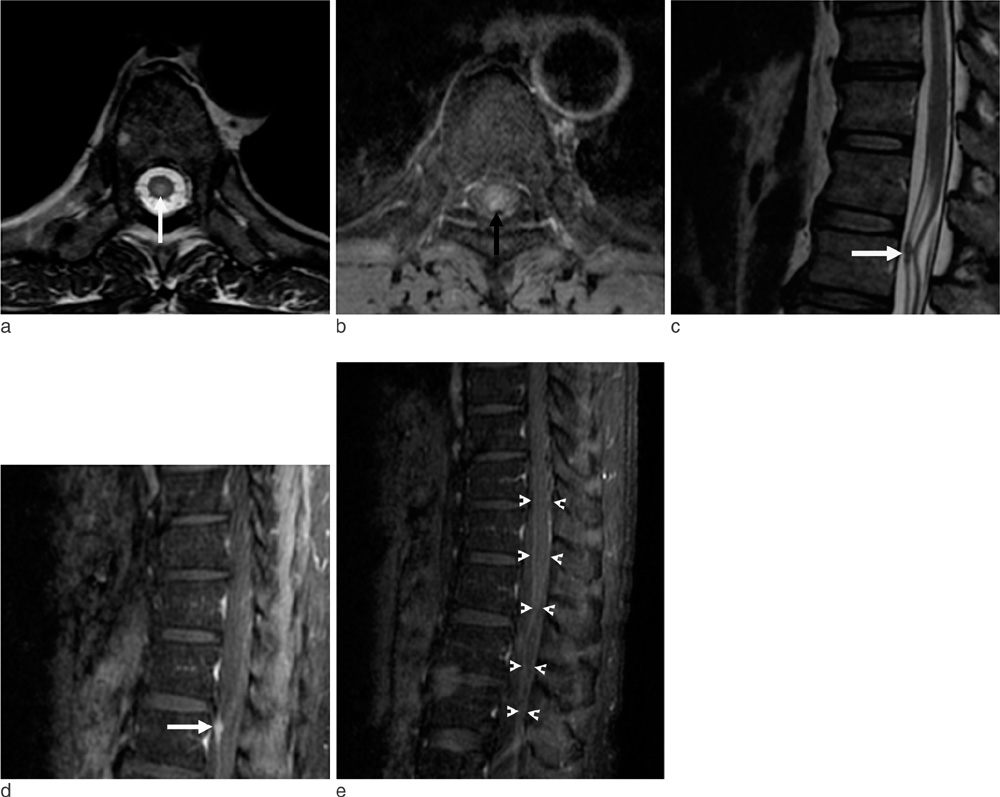J Korean Soc Magn Reson Med.
2014 Sep;18(3):263-268. 10.13104/jksmrm.2014.18.3.263.
Meningovascular and Spinal form of Neurosyphilis Presenting as Multiple Cranial Nerve Palsy, Cerebral Infarction and Meningomyelitis in a Human Immunodeficiency Virus Negative-Patient: MR Imaging Features
- Affiliations
-
- 1Department of Radiology, Inha University School of Medicine, Incheon, Korea. pengoon@gmail.com
- KMID: 1999927
- DOI: http://doi.org/10.13104/jksmrm.2014.18.3.263
Abstract
- Neurosyphilis is a rare infection of the brain and spinal cord caused by a spirochete named Treponema pallidum. We describe the magnetic resonance imaging of a 53-year-old man with syphilis who manifested as both meningovascular, and spinal meningomyelitic types, which involved the optic, trigeminal, facial and vestibulocochlear nerves, both middle and left posterior cerebral arteries, thoracic spinal cord and meninges of the lumbar spine. This case report suggests that neurosyphilis should be considered as a possible diagnosis in patients showing complex brain and spinal imaging features. These features include enhancing meningeal lesions with multiple cranial nerve involvement, stenoses in large to medium size cerebral arteries, and intramedullary and meningeal lesions of spine.
Keyword
MeSH Terms
-
Brain
Cerebral Arteries
Cerebral Infarction*
Constriction, Pathologic
Cranial Nerve Diseases*
Cranial Nerves
Diagnosis
HIV*
Humans
Magnetic Resonance Imaging*
Meninges
Meningitis
Middle Aged
Neurosyphilis*
Posterior Cerebral Artery
Spinal Cord
Spine
Spirochaetales
Syphilis
Tabes Dorsalis
Treponema pallidum
Vestibulocochlear Nerve
Figure
Reference
-
1. Tien RD, Gean-Marton MD, Mark AS. Neurosyphilis in HIV carriers: MR findings in six patients. AJR Am J Roentgenol. 1992; 158:1325–1328.2. Holland BA, Perrett LV, Mills CM. Meningovascular syphilis: CT and MR findings. Radiology. 1986; 158:439–442.3. Wharton M, Chorba TL, Vogt RL, Morse DL, Buehler JW. Case definitions for public health surveillance. MMWR Recomm Resp. 1990; 39:1–43.4. Yoon YK, Kim MJ, Chae YS, Kang SH. Cerebral syphilitic gumma mimicking a brain tumor in the relapse of secondary syphilis in a human immunodeficiency virus-negative patient. J Korean Neurosurg Soc. 2013; 53:197–200.5. Chilver-Stainer L, Fischer U, Hauf M, Fux CA, Sturzenegger M. Syphilitic myelitis: rare, nonspecific, but treatable. Neurology. 2009; 72:673–675.6. Nagappa M, Sinha S, Taly AB, et al. Neurosyphilis: MRI features and their phenotypic correlation in a cohort of 35 patients from a tertiary care university hospital. Neuroradiology. 2013; 55:379–388.7. Kikuchi S, Shinpo K, Niino M, Tashiro K. Subacute syphilitic meningomyelitis with characteristic spinal MRI findings. J Neurol. 2003; 250:106–107.8. Smith MM, Anderson JC. Neurosyphilis as a cause of facial and vestibulocochlear nerve dysfunction: MR imaging features. AJNR Am J Neuroradiol. 2000; 21:1673–1675.9. Jang JH, Kim EJ, Choi WS, Yoon SS, Heo SH. Neurosyphilis involving cranial nerves in brain stem: 2 case reports. J Korean Soc Radiol. 2012; 66:11–15.10. Seeley WW, Venna N. Neurosyphilis presenting with gummatous oculomotor nerve palsy. J Neurol Neurosurg Psychiatry. 2004; 75:789.11. Ghanem KG. Review: Neurosyphilis: A historical perspective and review. CNS Neurosci Ther. 2010; 16:e157–e168.
- Full Text Links
- Actions
-
Cited
- CITED
-
- Close
- Share
- Similar articles
-
- A Case of Neurosyphilis with Acute Optic Neuritis and Trochlear Nerve Palsy in Human Immunodeficiency Virus Infected Male
- Neurosyphilis Involving Cranial Nerves in Brain Stem: 2 Case Reports
- Cryptococcal Meningoencephalitis Presenting as Cerebral Infarction and Multiple Cranial Nerve Palsies
- Cerebral Gumma Mimicking a Brain Tumor in a Human Immunodeficiency Virus-Negative Patient: A Case Report
- Combined Facial and Contralateral Trochlear Nerve Palsy in a Patient with Diabetes Mellitus



